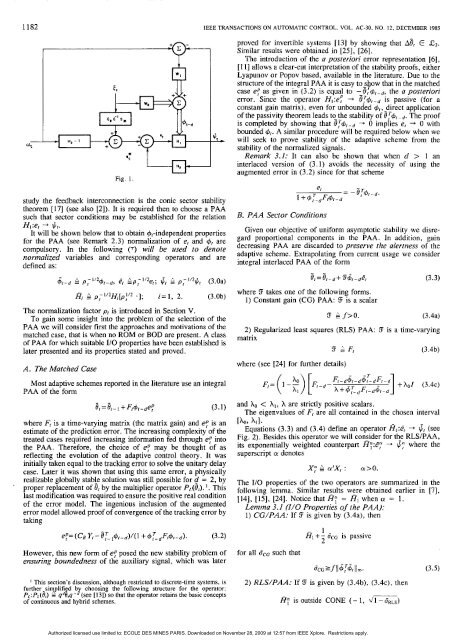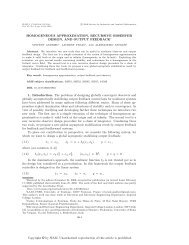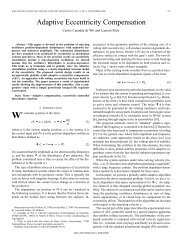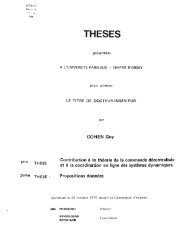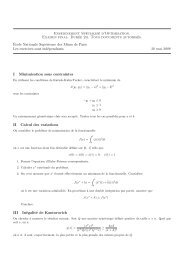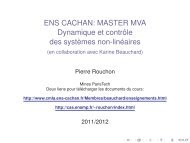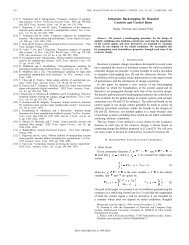Robustness of Discrete-Time Direct Adaptive Controllers - Centre ...
Robustness of Discrete-Time Direct Adaptive Controllers - Centre ...
Robustness of Discrete-Time Direct Adaptive Controllers - Centre ...
You also want an ePaper? Increase the reach of your titles
YUMPU automatically turns print PDFs into web optimized ePapers that Google loves.
1182 IEEE TRANSACTIONS ON AUTOMATIC COh'TROL. VOL. AC-30, NO. 12, DECEMBER 198514Lproved for invertible systems [I31 by showing that A8, E Oe2.Similar results were obtained in [25], [26].The introduction <strong>of</strong> the CI posteriori error representation [6],[ 1 I] allows a clear-cut interpretation <strong>of</strong> the stability pro<strong>of</strong>s, eitherLyapunov or Popov based, available in the literature. Due to thestructure <strong>of</strong> the integral PAA it is easy to_spow that in the matchedcase e; as given in (3.2) is equal to TO, i$-d, the a posteriorierror. Since the operator H,:e: + is passive (for aconstant gain matrix), even for unbounded +,,-direct application<strong>of</strong> the passivity theorem leads tcthe stability <strong>of</strong> 8 '41-d. The pro<strong>of</strong>is completed by showing that 8:&d + 0 impfies e, + 0 withbounded 4,. A similar procedure will be required below when wewill seek to prove stability <strong>of</strong> the adaptive scheme from thestability <strong>of</strong> the normalized signals.Remark 3.1: It can also be shown that when d > 1 aninterlaced version <strong>of</strong> (3.1) avoids the necessity <strong>of</strong> using theaugmented error in (3.2) since for that schemestudy the feedback interconnection is the conic sector stabilitytheorem [17] (see also [2]). It is required then to choose a PAAsuch that sector conditions may be established for the relationHI:e, --f $,.It will be shown below that to obtain +,-independent propertiesfor the PAA (see Remark 2.3) normalization <strong>of</strong> e, and 4, arecompulsory. In the following (:) will be used to denotenormalized variables and corresponding operators and aredefined as:2 p,-l'2+l-d, g, ~p,-"2e,; $ , = p;"'$, (3.0a)Hi- G * P, -l/2Hi,,1/2 .]; i= 1, 2. (3.0b)The normalization factor p, is introduced in Section V.To gain some insight into the problem <strong>of</strong> the selection <strong>of</strong> thePAA we will consider first the approaches and motivations <strong>of</strong> thematched case, that is when no ROM or BOD are present. A class<strong>of</strong> PAA for which suitable 110 properties have been established islater presented and its properties stated and proved.A. The Matched CaseMost adaptive schemes reported in the literature use an integralPAA <strong>of</strong> the form8,=8,-1+F,4,-de; (3.1)where F, is a time-varying matrix (the matrix gain) and e; is anestimate <strong>of</strong> the prediction error. The increasing complexity <strong>of</strong> thetreated cases required increasing information fed through e; intothe PAA. Therefore, the choice <strong>of</strong> e; may be thought <strong>of</strong> asreflecting the evolution <strong>of</strong> the adaptive control theory. It wasinitially taken equal to the tracking error to solve the unitary delaycase. Later it was shown that using this same error, a physicallyrealizable globally stab!e solution was still possible for = 2, byproper replacement <strong>of</strong> 8, by the multiplier operator PL(8,). I. Thislast modification was required to ensure the positive real condition<strong>of</strong> the error model. The ingenious inclusion <strong>of</strong> the augmentederror model allowed pro<strong>of</strong> <strong>of</strong> convergence <strong>of</strong> the tracking error bytakingB. PAA Sector ConditionsGiven our objective <strong>of</strong> uniform asymptotic stability we disregardproportional components in the PAA. In addition, gaindecreasing PAA are discarded to preserve the alertness <strong>of</strong> theadaptive scheme. Extrapolating from current usage we considerintegral interlaced PAA <strong>of</strong> the formwhere 5 takes one <strong>of</strong> the following forms.1) Constant gain (CG) PAA: 5 is a scalar5 2 f>O. (3.4a)2) Regularized least squares (RLS) PAA: 5 is a time-varyingmatrix5 2 F, (3 Ab)where (see [24] for further details)and X, < XI, X are strictly positive scalars.The eigenvalues <strong>of</strong> F, are all contained in the chosen interval[b, All.Equations (3.3) and (3.4) define an operator RI:P, + 6, (seeFig. 2). Besides this operator we will con_sider for th_e RLS/PAA,its exponentially weighted counterpart HY:Cp + $; where thesuperscript a denotesx; P a'X, : a>o.The I/O properties <strong>of</strong> the two operators are summarized in thefollowing lemma. Similar results were obtained earlier in [7],[ 141, [ 151, [24]. Notice that A;. = A, when a = 1.Lemma 3.1 (I/O Properties <strong>of</strong> the PAA):1) CG/PAA: If 5 is given by (3.4a), then+(cR YI-~T-I'#'I-~)/(~ +d':-dFrdl-d). (3.2)However, this new form <strong>of</strong> e; posed the new stability problem <strong>of</strong>ensuring boundedness <strong>of</strong> the auxiliary signal, which was laterfor all 6CG such that' This section's discussion, although restricted to discrete-time systems. isfurther simplified b] choosing the following structure for the operator:PL:Pr(!,) 2 qded- (see [13]) so that the operator retains the basic concepts<strong>of</strong> contmuous and hybrid schemes.2) RLS/PAA: If 3 is given by (3.4b). (3.4c), thenis outside CONE ( - 1, v'l - cRLS)Authorized licensed use limited to: ECOLE DES MINES PARIS. Downloaded on November 28, 2009 at 12:57 from IEEE Xplore. Restrictions apply.


